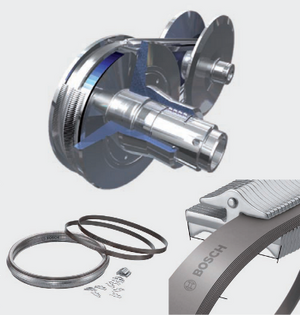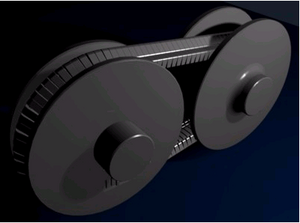Spatial Dynamics of Pushbelt Continuously Variable Transmission and Computational Time Reduction of the MBS Model
In automotive propulsion technology, Continuously Variable Transmissions (CVT) are an interesting alternative compared to conventional gear concepts like manual or automatic shift gears. CVTs help the combustion engine to stay closer to its optimal point of consumption and efficiency over a wide range of load cases.
Since 2001 the Institute of Applied Mechanics has been working successfully together with Bosch Transmission Technology B.V. (Gasoline Systems – CVT) on developing state-of-the-art multi-body simulation tools for the pushbelt variator of CVTs. The aim is to further optimize the pushbelt by using simulation software to e.g. reduce the fuel consumption.
A number of models and the appropriate software, such as the plane hybrid model or the spatial model, to consider also out-of-plane effects e.g. misalignment, have been designed. The development of mathematical models incorporates all elastic and dynamic effects. The pushbelt is a highly complex multi-body system (MBS), with about 3500 degrees of freedom and 5500 frictionless, frictional as well as uni- and bilateral contacts in the spatial case. The individual bodies are modeled either rigid or as finite elements with large deflections. To derive the equations of motion methods of non-smooth multi-body simulation are used. The resulting differential equations are being integrated with time-stepping methods. The software tool MBSim, which was developed at the institute, is used as program environment.
In the current research project the level of detail of the derived 3D-model is increased and extended by several additional properties. Thereby occurring effects outside of the actual plane of motion can be discussed in more detail. Since especially at high levels of detail the computational time is very large the second objective of this work is to reduce the CPU time. Therefore different reduction methods (e.g. model order reduction, parallel-processing, use of faster sub models) are taken into account. In this context the main difficulty is the transfer of these methods to general, non-smooth flexible multi-body-systems on the one side and to special conditions of the simulation model on the other side.

